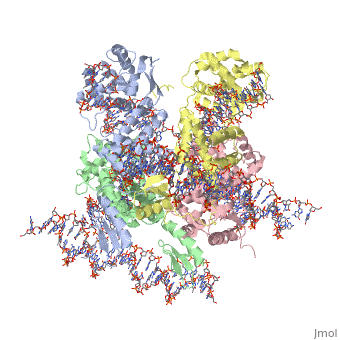1z1g
From Proteopedia
Crystal structure of a lambda integrase tetramer bound to a Holliday junction
Structural highlights
FunctionVINT_LAMBD Integrase is necessary for integration of the phage into the host genome by site-specific recombination. In conjunction with excisionase, integrase is also necessary for excision of the prophage from the host genome. Evolutionary ConservationCheck, as determined by ConSurfDB. You may read the explanation of the method and the full data available from ConSurf. Publication Abstract from PubMedSite-specific DNA recombination is important for basic cellular functions including viral integration, control of gene expression, production of genetic diversity and segregation of newly replicated chromosomes, and is used by bacteriophage lambda to integrate or excise its genome into and out of the host chromosome. lambda recombination is carried out by the bacteriophage-encoded integrase protein (lambda-int) together with accessory DNA sites and associated bending proteins that allow regulation in response to cell physiology. Here we report the crystal structures of lambda-int in higher-order complexes with substrates and regulatory DNAs representing different intermediates along the reaction pathway. The structures show how the simultaneous binding of two separate domains of lambda-int to DNA facilitates synapsis and can specify the order of DNA strand cleavage and exchange. An intertwined layer of amino-terminal domains bound to accessory (arm) DNAs shapes the recombination complex in a way that suggests how arm binding shifts the reaction equilibrium in favour of recombinant products. A structural basis for allosteric control of DNA recombination by lambda integrase.,Biswas T, Aihara H, Radman-Livaja M, Filman D, Landy A, Ellenberger T Nature. 2005 Jun 23;435(7045):1059-66. PMID:15973401[1] From MEDLINE®/PubMed®, a database of the U.S. National Library of Medicine. See AlsoReferences
| ||||||||||||||||||||


